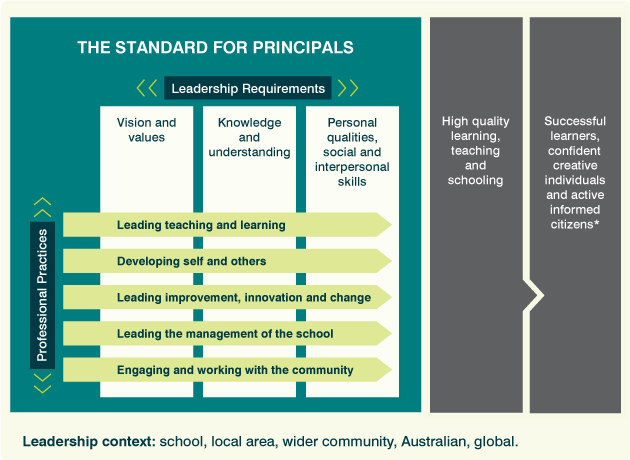The Australian Professional Standard for Principals (the Principal Standard) defines the professional practices of principals and leaders and the role of quality school leadership in improving student outcomes.
The Principal Standard is an integrated model that recognises the common capabilities and qualities of leaders. There are three leadership requirements that draw upon five areas of professional practice.

While the professional practices are detailed separately, they are always fully interdependent.
‘Leading teaching and learning’ is identified as one of the professional practices particular to the role of the principal. Within this domain of learning, principals have a responsibility to develop a culture of effective teaching for improved student outcomes.
Leaders also build and sustain a culture for actively and respectfully engaging with the community, including with Aboriginal and Torres Strait Islander communities, parents and learners; recognising that no student can learn unless they feel safe and welcome in their education setting.
To lead the improvement of teaching practice, principals and leaders must understand and be able to explain what quality looks like. By developing their own expertise about effective practice, leaders can lead and guide professional learning, target and align resources, and engage in ongoing capacity building. Leading conversations about teacher practice means developing a familiarity with the Standards.
Leaders who are supervising preservice teachers and want hands-on help with how to improve the experience for them, as well as supporting their understanding and application of the Standards, can look at Supervising Preservice Teachers.
National teacher certification, as outlined in Certification of Highly Accomplished and Lead Teachers in Australia was endorsed by Education Ministers in April 2012. National teacher certification uses the Standards to make rigorous judgements regarding the certification of teachers at the Highly Accomplished and Lead (HALTs) career stages.
Certification recognises quality teaching amongst staff. It highlights the value of nationally certified teachers to an education setting, including to students, staff and the wider school community.
Leaders are provided with a greater understanding of their role and responsibility in supporting teachers through national teacher certification. It helps them understand the steps to enable teachers to pursue national teacher certification.
Leaders can explore Getting the best from your teachers – A principal’s guide to national teacher certification for more information on HALTs.
A mentor is a knowledgeable and experienced teacher who works with (or alongside) a colleague looking to improve their practice. It’s not just for new teachers — experienced teachers can also get value out of having a mentor. It is a structured relationship with clear planning and goals.
Mentoring can involve regular meetings and check-ins, classroom observations and debriefs as well as other professional learning conversations. Teachers can have a mentor observe their teaching to provide feedback, or they can watch their mentor in action.
Highly successful mentoring:
- is based on the teacher and mentor having common teaching areas
- helps improve practice through coaching, supporting, and challenging the beginning teacher
- addresses subject content and teaching practices
- focuses on learner outcomes and encourages the beginning teacher to reflect through observations and data
- extends over a period of time
- is embedded in daily practice
- is practice-focused to develop pedagogical skills.
For the practice of mentoring to be most effective the mentor needs to measure their own impact through reflective routines, goal setting and the collection and analysis of evidence.
Mentoring has many benefits for the mentor, the mentee, and the teaching profession.
Mentoring helps beginning teachers feel connected to their profession and their education setting and helps foster the development of a professional identity. Other benefits include:
- teachers who are mentored are more likely to stay in teaching
- high-quality mentoring can lead to improved learner achievement
- highlighting areas for future professional learning for both the mentor and the mentee
- the opportunity to evaluate and reflect on learning
- it can be part of evidence used for certification as a Highly Accomplished or Lead Teacher.
Mentoring is also a form of tailored professional learning, where a mentor can see their mentee in the classroom and provide immediate feedback and support.
Now that you have completed Module 1, take this opportunity to revisit some of the reflection questions you answered at the start of Module 1a. Answer the questions either by yourself, as part of a team, or with a critical friend/mentor and consider if your responses are different after completing this module.
How do the Standards make a difference to you as a teacher and/or leader?
How are the Standards being used in your education setting?
In your education setting, is professional learning selected based on identified areas in the Standards where improvement is needed?
How do the Standards assist in defining effective teaching?
Does your education setting have a shared understanding of effective teaching? How could you help to shape/build/develop this?
If there was/was not a shared understanding of effective teaching, what effect would this have on the culture?
These additional resources could be used in your school to build understanding and application of the Standards.
Illustrations of Practice
See the Standards in action across a range of career stages, focus areas, context, year levels and subject areas. There are over 300 videos with real teachers demonstrating their practice.
My Induction app
My Induction app includes expert advice and activities to help pre-service and beginning teachers start their teaching career.
Teacher Self-Assessment Tool
The Teacher Self-Assessment Tool is a free online questionnaire enabling teachers at all career stages to reflect on their practice in line with the standards.
Classroom Practice Continuum
The Classroom Practice Continuum brings the Standards to life by building out the Professional Practice Domain and articulating what teachers at increasing levels of expertise do in the classroom.
Move forward to:
Alternatively, return to the: